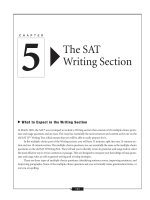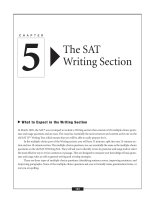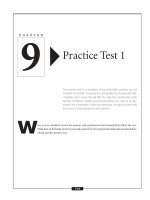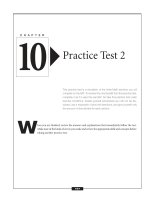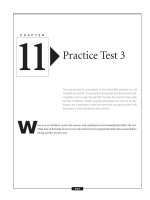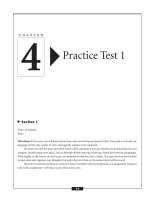SAT Writing Essentials - The Essay
Bạn đang xem bản rút gọn của tài liệu. Xem và tải ngay bản đầy đủ của tài liệu tại đây (180.93 KB, 20 trang )
T
his chapter is designed to help you do just that. You’ll learn how to tackle the two types of prompts,
how to budget your time, and how to organize your writing. You’ll get to practice by quickly coming
up with thesis statements and introductory “hooks” for a number of prompts. Also included are three
essays for you to score and study, one that meets the requirements for the highest score, a six, and two that earn
lower scores. Preparation, through study and practice, will help you develop a strategy for approaching the essay.
That strategy will make you more confident when you face the SAT essay, help you use each minute to full advan-
tage, and result in a higher score.
CHAPTER
The Essay
The SAT essay is in many respects unlike any other kind of writing
you’ve had to do. While the fundamentals of good writing remain a con-
stant, the approach to this task is radically different. You don’t have time
to brainstorm, outline, revise, and edit the way you would if the clock
wasn’t ticking. When you have just 25 minutes, each one counts. The
scorers know this, so they’re trained to look for “polished rough drafts.”
Does that mean you can forget about spelling, verb tenses, and idioms?
Not exactly. How can you produce a high-scoring essay, while under
pressure? The key is preparation.
3
55
The Issue of Space
Some recent test takers report that they were shocked by the small amount of space they were given
on their answer sheet to write the essay. Although you can use the test booklet to take notes and
organize your thoughts, only what is written on the answer sheet will count. The practice tests in
Chapters 4–6 include the same amount of space you’ll encounter when taking the SAT, so you will
be able to walk into the test confident that there will be no surprises.
56
Strategies for Timed Essays
As we’ve said, you are not expected to turn in a final-
draft essay, but instead you’re creating a “polished
rough draft.” A couple of minor errors in grammar,
usage, and mechanics will not be weighed against you.
Scorers read the essay to get an overall impression of
your writing ability. They look for evidence of critical
thinking: How well did you respond to the topic,
develop a point of view, and use appropriate examples
and evidence to support your position? Is your essay
clearly focused, and does it transition smoothly from
one point to the next? Do you show evidence of having
a varied and intelligent vocabulary? Since readers spend
approximately three minutes on each essay, it’s impor-
tant to hit each of the marks they’re looking for.
Official Directions
As with the multiple-choice questions, it’s important
that you study the directions for the essay as part of
your preparations. You don’t want to waste time read-
ing them during the test. Official directions are at
www.collegeboard.com. Either print them out, or copy
them, and then study them. Here are some of the key
points stressed in the directions:
■
Choose a point of view to argue, and stick to it
(don’t mention both sides of an argument while
flip-flopping back and forth).
■
Develop your ideas logically (use transition
words, and don’t jump randomly from one
thought to another).
■
Support those ideas with appropriate examples
and evidence (think concrete and precise—don’t
make assertions you can’t back up).
■
Use clear, concise language, and proofread for
spelling, punctuation, and grammar mistakes
(“big words” used to show off and long compli-
cated sentences won’t get you points).
■
Write only in the space provided (wide margins,
skipping lines, large indents, and handwriting
that’s too big will waste space).
Scoring
Two graders, who are high school or college English or
writing teachers, will read your essay. They are trained
to spend two to three minutes on each essay, and then
give it a score of 1–6 (although an essay that is written
off-topic gets a zero). Your total score will be in the
range of 2–12. If the graders disagree by more than a
point, a third reader will be given your essay.
Although readers will give your essay one score
based on a holistic response, they look at four areas to
determine that score: meaning (content), development
(support), organization (flow of ideas), and language
use or mechanics (grammar and punctuation). Scores
range from a low of 1 (showing writing incompetence)
to a maximum of 6 (demonstrating clear and consistent
competence).
The graders will focus on the strength of your
argument. Are you convincing? Do your ideas make
sense? Do you have insightful, supported comments on
the topic? Do your ideas flow logically? Your writing
style will also be judged (but keep in mind that a few
stray commas and spelling mistakes will be forgiven).
Overall, are you observing the standard rules of gram-
mar, punctuation, and spelling? Is your vocabulary
sufficient to adequately put forth your ideas? Are your
sentences varied?
In the box below are criteria that are more specific
for each essay score.
–
THE ESSAY
–
57
Scoring
Score of 6
A 6 essay stands out because of its thinking; it has
a strong point of view, which is developed in an
organized, focused manner. Examples and evi-
dence are used to support the point of view. There
may be a few errors in grammar, usage, and/or
mechanics, but word choice (vocabulary) and struc-
ture (varied sentences) show mastery of language
and writing skills.
Score of 5
A 5 essay is also effective in the position it takes
and how it develops that position, but it has more
errors than a 6 essay. It uses examples and evi-
dence skillfully, and presents its argument in an
organized way. A strong vocabulary is evident.
Score of 4
An essay in this category is adequate, developing
a position reasonably well, and supporting it with
examples and evidence. Its organization and focus
will be weaker than that of a 5 essay. There will be
errors in language, grammar, and mechanics.
Score of 3
This essay is inconsistent. While some elements
may be adequate, such as demonstration of critical
thinking skills or use of appropriate examples, oth-
ers are weak. It may lose focus and provide evi-
dence for some points but not others. There will be
little or no variety in sentence structure, and a num-
ber of errors in spelling, grammar, and punctuation.
Score of 2
A 2 essay is inadequate. Its point of view will be
weak, poorly developed, and/or insufficiently sup-
ported. There is a lack of organization and evidence
of poor language skills. Errors in mechanics, word
choice, grammar, and spelling will be serious and
plentiful.
Score of 1
This essay will be incoherent, with no clear position
taken or supported. It will be disorganized, with
serious errors in vocabulary, sentence structure,
grammar, and mechanics. These errors will prevent
the reader from understanding the essay.
Score of 0
No matter how well written, essays that do not
address the assignment are scored zero.
Understanding the Prompts
The assignment of the essay is to respond thoughtfully
and skillfully to a prompt, which will be one of two
types:
■
Response to a quote. You are given one or two
quotes and asked to evaluate or compare them in
response to a question.
■
Completion of a statement or idea. You are given
an incomplete statement and asked to fill in the
blank, then use the completed statement as the
basis for your essay.
Responding to Quotes
Here’s an example of this type of prompt:
Good fences make good neighbors.
—Robert Frost
Assignment: In Frost’s poem “Mending Wall,” a man
tells his neighbor “good fences make good neighbors,”
suggesting that clear boundaries are needed for people
to get along with one another. Do you agree or disagree
with this idea? Develop your point of view, supporting
it with an example (or examples) from literature, the
arts, history, current events, politics, science and tech-
nology, or personal experience or observation.
When faced with a quotation, determine what is
being said, and rewrite it succinctly, in your own words,
before you begin your essay. For example, in response
to the above quotation, you may write “when people
have their own space, and feel that space is protected,
they get along better with others.” Then, look at the
assignment for more details about how to proceed.
Here, the task is to develop a point of view that agrees
or disagrees with the quote’s assertion.
Another prompt of this type asks you to choose
between two opposing ideas expressed in quotations, as
seen below:
Better a lie that soothes than a truth that hurts.
—Czechoslovakian proverb
Truth is the only safe ground to stand on.
—Elizabeth Cady Stanton
Assignment: Consider the two contrasting statements
above. Choose the quotation that most closely reflects
your viewpoint. Write an essay explaining your choice.
To support your view, use an example or examples
from history, politics, science and technology, litera-
ture, the arts, current events, or your own personal
experience and observation.
Again, the first step is to be certain of what each
author is trying to say. Once that’s determined, choose
the side for which you can immediately think of some
good examples or evidence. You don’t truly need to
agree with the quotation to write a strong essay, and you
won’t have time to change your mind. Choose a side,
and get going. Remember that a well-developed point
of view is what the readers look for; they have no idea
whether you really believe that view.
Completing a Statement or Idea
The other type of question you may confront will ask
you to complete a sentence or idea, such as the one that
follows:
People often say it’s better to be safe than sorry. I
felt the truth of this statement when . . .
Assignment: Complete the sentence above with an
appropriate phrase. Then, write an essay supporting
your completed statement.
–
THE ESSAY
–
58
This question type requires that you think of
examples and situations that illustrate the statement.
Readers will be looking for a clear, strongly supported
account of an event that led you to appreciate the need
to be careful. This question easily lends itself to use per-
sonal experience. Or, you could answer using a histor-
ical event with which you are very familiar. No matter
how you address the question, the point is not just to
make claims or assertions, but also to back them up
with evidence and examples.
The Art of Persuasion
Both types of essay prompts call for a persuasive essay,
one in which you choose an idea and show why it is
legitimate or worthy. Your purpose is not to merely
explain your point of view, but to convince your reader
why it makes sense. In order to persuade effectively, you
must base your argument on reasoning and logic.
If you are unsure or undecided in your stance,
your writing will be weak and your score will suffer.
However, your opinion is not enough. Like a lawyer
before a jury, you must convince your reader with evi-
dence that your opinion is valid. This evidence consists of
concrete examples, illustrations, and details. Therefore,
the most important strategy for the persuasive essay is
to choose the side that has the best, or most, evidence. If
you believe in that side, your argument will most likely be
even stronger (although, as mentioned above, you don’t
have to believe in it to write a good essay).
The essay does not require specific knowledge of
literature, history, or current events. However, the top-
ics are broad enough that you will probably be able to
use your knowledge from these areas to answer the
question. While you can always rely on personal expe-
rience, as many high-scoring essays do, it’s a good idea
to review areas you’ve studied or are otherwise familiar
with to use on test day (don’t try to learn new material
for the essay). Here are some ideas for what to review:
■
Literature: poems, novels, plays, and myths with
broad themes that can be applied to a number of
topics. Orwell’s Animal Farm, for example, could
be used to discuss equality (“some animals are
more equal than others”), the class system, or
forms of government.
■
History: events and time periods such as World
War II, the Great Depression, treatment of Native
Americans, and America’s break from British
rule. Historical events may be written about from
many perspectives, and can be used to make
points about a variety of subjects. The Depres-
sion, for example, was an economic event that
had many factors, including human emotion
(fear).
■
Science: technology, space exploration, the con-
cept of absolute zero, acid rain, and other envi-
ronmental issues. For example, you could discuss
global warming in terms of man’s disregard for
the planet, or in terms of a positive worldwide
response that is bringing together many nations.
Whatever the subjects you’ve studied, think in
terms of flexibility. How many different ways can you
look at an event, an invention, or a work of non-fiction?
What does it mean to people, how do they respond to it,
or how has it changed the world (for better or worse)?
Having a few adaptable subjects fresh in your mind may
help you respond quickly, specifically, and thoroughly to
what will most likely be a very general prompt.
Anatomy of an Essay
Unfortunately, 25 minutes is not enough time to come
up with an innovative structure for your essay. You
need to address the topic in a clear, well-organized
fashion, using examples and details to make your point.
The best way to accomplish those goals is to stick to a
traditional format, the five-paragraph essay. Aim for an
–
THE ESSAY
–
59
introduction, three body paragraphs, and a concluding
paragraph. By writing within this format, your ideas
will be easily available to your reader (the person scor-
ing your essay), and you will have more time to develop
and substantiate them.
Introduction: Thesis Statement
and Hook
The introduction presents the reader with your topic
and point of view. It is more general than the body
paragraphs of the essay, which contain the specific
examples and evidence that help you substantiate and
develop your topic. The goal of the introduction is to
make the reader clearly understand your position,
without being trite or boring. To accomplish it, you’ll
need to write two things: a thesis statement and a
hook.
A clear thesis statement is one sentence that
refers directly to the topic. It gets right to the point,
because the real meat of your essay, where you can
deliver the greatest impact to the reader, is in the body.
Stating your thesis quickly and clearly means avoiding
disclaimers such as “I’m not sure, but . . .” and “This
may not be right . . .” Such disclaimers are a waste of
time, and will lose points with your reader. No matter
how strong your argument becomes in later para-
graphs, that initial poor impression will stick. Instead, be
confident and direct. A clear thesis statement shows
the graders that you understand the assignment and
have formulated a relevant response to it. It also sets
the stage for a well-developed essay in which specific
and interesting examples support it.
But direct doesn’t mean trite. Relying on over-
used words and phrases to help make your point is the
most common way to weaken your introduction.
Compare: “In today’s society, people don’t practice
good manners often enough,” with “Good manners
are an essential part of a civil society.” The problem
with the first sentence is the first three words. “In
today’s society” is a clichéd opening, whereas the sec-
ond sentence makes its point directly, without any
overused language.
Once you’ve narrowed down your topic, and
have a clear, confident thesis statement, think about
how to grab your reader’s attention. Imagine you’re an
essay grader reading hundreds or thousands of SAT
essays. It’s late and you’re tired. Which of the following
first sentences would make you sit up and take notice
of the essay?
Imagine a world in which plant life is reduced to
a few hardy specimens, drought is common-
place, and the world’s coastal regions are under
water.
OR
The future effects of global warming will be
bad.
The first sentence is a hook; it is designed to
inspire the reader to want to read the rest of the essay.
How can you come up with something so seemingly
clever and innovative in a minute or two? It’s not as
hard as it looks; what at first glance appears clever and
innovative is really the product of a learned method.
Two types of hooks are quick and easy to create. If you
study them, and practice writing them from sample
prompts, you’ll be able to write a hook for your essay.
One type of hook is used in the first example
above: a dramatic scenario, saying, or statistic.A sce-
nario paints a vivid picture with words. A related sta-
tistic, proverb, or other saying can boldly introduce
your topic, show off your knowledge, and give your
writing some heft. Statistics in particular add a tone of
–
THE ESSAY
–
60
seriousness and importance to your writing; they say
“I’m not the only one who thinks this way—there are
studies to back me up.” Compare:
Not only is the number of overall incidents of
cancer in Americans decreasing, but survival
rates are dramatically increasing.
To :
More people survive cancer these days.
The other type of quick hook to study and prac-
tice is questioning. Pose a specific, relevant question to
your reader that will naturally lead into your topic. In
the introductory paragraph below, the hook is in bold.
Example
Is the difference between a good neighbor and a
bad neighbor simply that one doesn’t hit base-
balls through your windows, and the other does?
It’s not that simple. There are many qualities of a
good neighbor, and one of the most important is dis-
tance. Having your own space, and having your
neighbor respect that space, is the key to a good
next-door relationship. This is true whether dis-
cussing the person whose lawn abuts yours, the
students you attend class with, or the nation with
which yours shares a border.
In this introductory paragraph, the three exam-
ples that will be explored in the essay are mentioned.
This is a great way to transition the reader from the
introduction to the body of the essay. However, it’s not
always possible to have those three examples at the
ready. What if you have two, but are betting the third
will come to you while writing the body? It’s still bet-
ter to give the reader an idea of the direction you’re
headed before jumping into the body of the essay. This
technique shows off your thinking skills and your abil-
ity to organize your ideas.
–
THE ESSAY
–
61
Common “Hook” Mistakes
1. Using a title as a hook
Titles are typically incomplete sentences, such as The March of Progress or My Soccer Team’s Lesson. A
hook is a sentence or couple of complete sentences that draw the reader in. The use of phrases or clauses
instead of complete sentences in your essay will lose points.
2. Using an announcement as a hook
Don’t address your reader directly with an announcement or literary road map of where you’re going. “This
essay will be about man’s triumph over natural disasters” is not sophisticated enough for the SAT essay.
3. Confusing a thesis statement for a hook
Your thesis statement gets right to the point. As an opening sentence, it’s probably dull. The addition of
a hook will ensure a better, more interesting introduction.
The Best Way to Achieve a High Score
Readers of your essay are specifically looking for a key element that can make or break your score: is every
point you make supported with details, examples, and evidence? Not only will these elements strengthen
your argument, but they’ll also make your writing come alive. One way to assure that you’ll include
enough supportive information is to write at least one sentence in each paragraph that begins with the
words, “For example.”
Compare these paragraphs:
High school seniors should be allowed open campuses, on which they can arrive in time for their
first class, leave during free periods, and come back to school for their other classes. There is no
reason to treat high school seniors like children by making them stay in school all day when they
don’t have classes to attend all day. Seniors can handle the extra responsibility.
High school seniors should be allowed open campuses, on which they can arrive in time for their
first class, leave during free periods, and come back to school for their other classes. Seniors are
given freedom and responsibility in many other areas of their lives; for example, the ability to drive
a car. Seniors are also permitted to vote, and to prepare for their futures through the college admis-
sions process or vocational training.
The first example uses generalizations and unsubstantiated claims (“no reason to treat them . . .” “can
handle the extra responsibility”), which add nothing to the argument. The second uses evidence, such as
the responsibility of driving and voting, to make the case for open campuses. Writers of high-scoring
essays back up what they say with evidence, details, and other types of examples.
Body
In the body of your essay, you develop and illustrate
your ideas on your topic. It is where you add the inter-
esting details and examples that support your thesis and
make your essay stand out. The body should be three
paragraphs, one for each example or idea.
It’s been said already that a few small grammar or
mechanics errors will be overlooked. However, you
probably noticed when reading the scoring rubric that
sentence variety is important to your reader. Don’t use
too many short, choppy sentences; vary your sentence
structure so that your reading is interesting and flows
easily.
–
THE ESSAY
–
62



